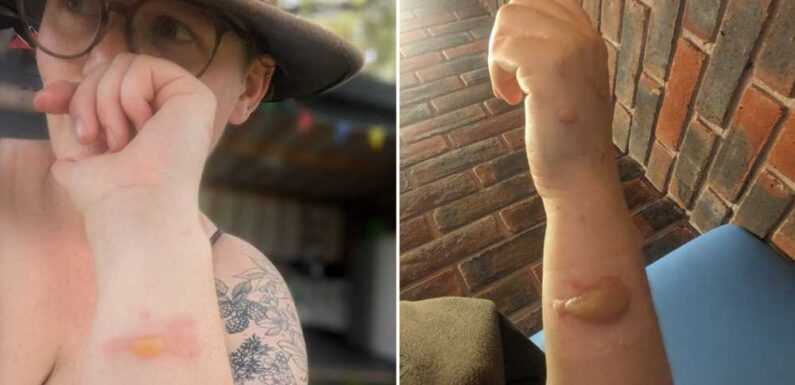
A GARDENER was left with "painful" blisters despite wearing gloves after brushing against dangerous bush.
Robin Hankins was working in a garden in Dorset when she touched the invasive plant.
Unaware the poisonous plant got into her skin, Robyn, 28, continued working in the garden in Corfe Mullen.
But she was left shocked when painful blisters appeared all over her arm the next day.
Ms Hankins said: “I was wearing long sleeves and gloves and was unaware its sap had touched my skin.
“Nothing appeared on my skin until I woke the next morning when I had red burns on my arm and hand. They got progressively worse over a period of three days.
Read More warnings
Warning to families heading to Italy over paralysing virus spread by mosquitoes
Warning over new AI camera fines as 300 motorists are caught out in three days
"It was only a small affected area, though once the burn marks appeared it was very painful.”
Hogweed or cow parsnip is an invasive species dubbed by experts as "Britain's most dangerous plant"
The sap of this wildflower can get into the skin causing serious injuries.
The plant contains a toxin which can kill skin cells removing UV protection.
Most read in Health News
What you need to know about Eroxon gel and how to buy it
UK salary for junior doctors explained
What is giant hogweed and what does the toxic plant look like?
DNA tests at GP surgery will spot cancer risks early and save lives
The affected skin then becomes highly sensitive to sunlight resulting in nasty burns and irritation.
The plant is easily mistaken for harmless bushes in parks or woodland.
But Robyn is urging people to be on the lookout after she ended up seeking urgent medical care.
She said: “I first spoke to a pharmacist who suggested hydrocortisone cream, I then sought out a doctor on day four as it was not improving.
“The doctor asked for help from a nurse, who drained the largest blister to relieve some pain and covered the wound.
“However she left the two smaller blisters untreated.
“She had never heard of hogweed or that it was dangerous.”
The gardener from Wimborne Minster is now advising people to avoid the plant.
Robyn added: “Even if you think you are being careful it can still get on your skin.
"I had long sleeves and gloves due to its nature and it still got on me.
“So remove clothing and wash after dealing with it regardless of whether you think it is on you or not.”
Read More on The Sun
People are just realising why Snickers has its bizarre name
My face ballooned & I was hospitalised after I got eyelash extensions
The alarm comes as another man was left covered in golf ball-sized blisters after he and his little brother touched a dangerous plant.
Daniel, 21, brushed past giant hogweed while retrieving a football from a bush in Boston Manor Park in Brentford, West London.
What is giant hogweed and how to treat burns?
The giant hogweed is native to the Caucasus, but was introduced to Britain as an ornamental plant in 1817, and its spread has now got out of control.
Mike Duddy, of the Mersey Basin Rivers Trust, said in 2015 that the giant hogweed was "without a shadow of a doubt, the most dangerous plant in Britain".
The giant hogweed's sap stops the skin protecting itself against the sun's rays, leading to gruesome burns when exposed to natural light.
Part of what makes it so dangerous is that it usually causes no immediate pain, so its victims can continue to burn in the sunshine heedless of any problem.
And it only takes a moment of exposure for the sap to do its work.
If exposed to the plant, you should thoroughly wash the area that made contact and keep it out of sunlight for a few days, the Woodland Trust advises.
Source: Read Full Article










